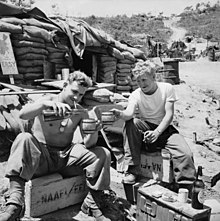| British Commonwealth Forces Korea | |
|---|---|
 Indian, British, New Zealander and Australian soldiers in Korea, c. March 1951. | |
| Active | 1950–1956 |
| Country | |
| Allegiance | |
| Type | Rapid reaction force |
| Garrison/HQ | 1st Commonwealth Division |
| Engagements | Korean War |
British Commonwealth Forces Korea (BCFK) was the formal name of the British Commonwealth army, naval and air units serving with the United Nations (UN) in the Korean War. BCFK included Australian, British, Canadian, Indian, and New Zealand units. Some Commonwealth units and personnel served with United States and/or other UN formations, which were not part of BCFK. [1]
History
In 1950, Australian units based with the British Commonwealth Occupation Force (BCOF) in Japan were among the first UN personnel to be deployed in South Korea. After the administrative support role of BCOF in Japan to the fighting forces in Korea had been decided in November 1950, the title BCFK appeared. [2] The position of BCFK Commander-in-Chief was always held by Australian Army officers, the first being Lieutenant General Sir Horace Robertson. Liaison between the Commonwealth C-in-C and the UN high command was provided by a subordinate headquarters in Tokyo.

Seven months after BCFK came into being, the Commonwealth armies formed the 1st Commonwealth Division (in July 1951) and British and Canadian Army personnel predominated at the operational level in the Commonwealth land forces. Lieutenant General William Bridgeford took over from Robertson in October 1951, and he was later succeeded by Lieutenant General Henry Wells. Wells was succeeded by Lieutenant General Rudolph Bierwirth in 1954 and Brigadier Leonard Bruton in 1956.
The Royal Navy usually had at least one aircraft carrier on station during the war. Five British carriers: Glory, Ocean, Theseus, Triumph, and Unicorn (a maintenance and aircraft transport carrier) served in the conflict. The Royal Australian Navy provided the carrier HMAS Sydney. The RN, RAN and Royal Canadian Navy also provided many other warships. The Royal New Zealand Navy deployed a number of Loch class frigates throughout the war.
The RN carriers provided the only British fighter planes to take part in the war. On 9 August 1952 a propeller-driven Sea Fury, piloted by Lieutenant Peter Carmichael of No. 802 Squadron, based on HMS Ocean, shot down a MiG-15 jet fighter, becoming one of only a handful of pilots of propeller planes to have shot down a jet.
The only front-line unit from a Commonwealth air force to serve under BCFK was Royal Australian Air Force (RAAF) No. 77 Squadron, which initially flew P-51 Mustang fighters and later converted to Gloster Meteor jets. British and Canadian aircrews also served with the RAAF. The only Royal Air Force contribution was a wing of Short Sunderland flying boats based at Iwakuni in Japan.

See also
- 1st Commonwealth Division
- KATCOM
- United Nations Memorial Cemetery in Busan, Korea, where a total of 1589 Commonwealth casualties are buried.
- Korean War Memorial in London
Footnotes
- ^ For example, No. 2 Squadron, South African Air Force was part of the US 18th Fighter-Bomber Wing in Korea, flying P-51s and F-86s.
- ^ Jeffrey Grey, The Commonwealth Armies and the Korean War: An Alliance Study. Manchester University Press ND, 1990, ISBN 0719027705, 9780719027703, p. 110
Further reading
- Farrar-Hockley, Anthony (1990). The British Part in the Korean War Volume I: A Distant Obligation. London: HMSO. ISBN 0116309539.
- Farrar-Hockley, Anthony (1995). The British Part in the Korean War Volume II: An Honourable Discharge. London: HMSO. ISBN 011630958X.
- Lansdown, John R. P. (1997). With the Carriers in Korea: The Naval and Air War in SE Asia, 1950-1953. Wilmslow, Cheshire: Crecy Publishing Ltd. ISBN 0-947554-64-5.
External links
- Lt Col. John C. Blaxland, 2004, The Korean War: Reflections on Shared Australian and Canadian Military Experiences
- Historical Section, General Staff, Army Headquarters, 1956, Canada's Army in Korea: the United Nations Operations, 1950-53, and their Aftermath
- Royal Engineers Museum Royal Engineers and the Cold War (Korean War)
- Royal Engineers Museum
Royal Engineer pictures of the Korean War
- Invasions of Inchon and Wonsan remembered French and English supported operations. Allies provide a unique perspective of naval operation in the Korean War ...
- (in English and French) EuroKorVet European Korean war Veterans website (non-off)
- History of the Commonwealth of Nations
- Military units and formations of the Korean War
- British Commonwealth units and formations
- Military units and formations established in 1950
- United Nations Forces in the Korean War
- Military units and formations of the United Kingdom in the Korean War
- South Korea–United Kingdom relations
- Military units and formations of India
- British Commonwealth Occupation Force
